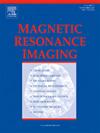Correction of orientation dependence in magnetization transfer measures in the context of tractometry: Challenges, pitfalls and solutions
IF 2
4区 医学
Q2 RADIOLOGY, NUCLEAR MEDICINE & MEDICAL IMAGING
引用次数: 0
Abstract
In this work we investigate the feasibility of a correction method for removing the orientation dependence of magnetization transfer (MT) measures in the context of tractometry. Following previous work on the track-based characterization of such orientation dependence using diffusion MRI, a correction method was developed. It uses polynomial fits to extrapolate the single-fiber characterizations and allows the MT measures across all white matter tracks to be shifted towards a chosen reference value, effectively removing the bias of fiber orientation with respect to the main magnetic field. Three different references were tested on a dataset of one hundred acquisitions and the performance was accessed by evaluating the removal of the orientation dependence and the reduction of variance between acquisitions, while also exploring the effects on tractometry results. Throughout these experiments, various challenges and pitfalls of an empirical correction method were laid out, like the absence of ground truth or the lack of knowledge about the complex behavior of the phenomenon in crossing-fiber voxels. Nonetheless, a solution was presented, paving the way towards a fully validated correction method for MT measures.
牵引法中磁化转移测量中方向依赖性的修正:挑战、缺陷和解决方案。
在这项工作中,我们研究了一种校正方法的可行性,以消除磁化转移(MT)措施的取向依赖在牵引法的背景下。在先前使用扩散MRI对这种取向依赖进行基于轨迹的表征之后,开发了一种校正方法。它使用多项式拟合来推断单纤维特性,并允许跨所有白质轨道的MT测量向选定的参考值移动,有效地消除光纤方向相对于主磁场的偏差。在100个采集的数据集上测试了三种不同的参考文献,并通过评估去除方向依赖和减少采集之间的方差来访问性能,同时还探索了对测束结果的影响。在这些实验中,提出了经验校正方法的各种挑战和陷阱,例如缺乏基础真理或缺乏对交叉纤维体素中现象的复杂行为的了解。尽管如此,还是提出了一个解决方案,为MT测量的完全验证校正方法铺平了道路。
本文章由计算机程序翻译,如有差异,请以英文原文为准。
求助全文
约1分钟内获得全文
求助全文
来源期刊

Magnetic resonance imaging
医学-核医学
CiteScore
4.70
自引率
4.00%
发文量
194
审稿时长
83 days
期刊介绍:
Magnetic Resonance Imaging (MRI) is the first international multidisciplinary journal encompassing physical, life, and clinical science investigations as they relate to the development and use of magnetic resonance imaging. MRI is dedicated to both basic research, technological innovation and applications, providing a single forum for communication among radiologists, physicists, chemists, biochemists, biologists, engineers, internists, pathologists, physiologists, computer scientists, and mathematicians.
 求助内容:
求助内容: 应助结果提醒方式:
应助结果提醒方式:


